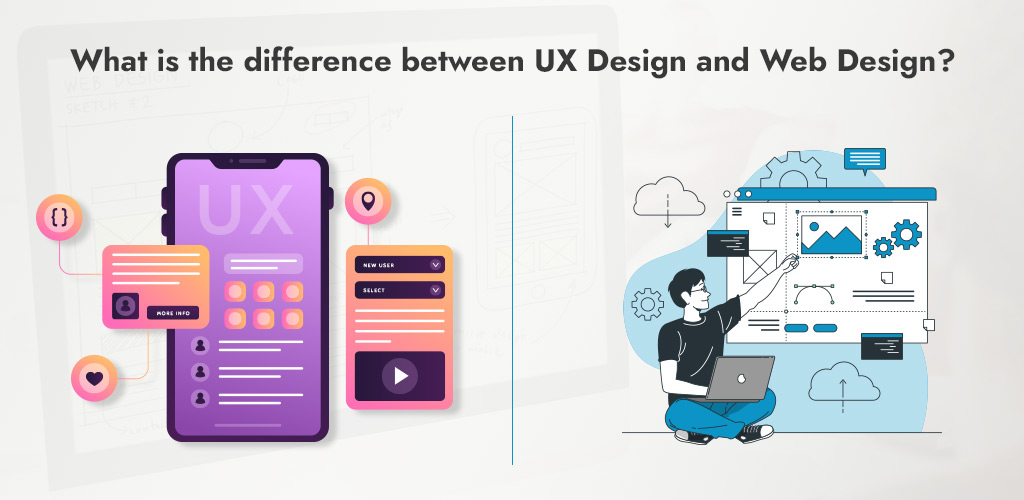
Websites that meet users’ needs and expectations regarding functionality, aesthetics, and ease of use while being trustworthy are held in the highest respect. All too frequently in online design, aesthetics take precedence over practicality and performance. When websites don’t function as planned, customers may get unsatisfied owing to a lack of forethought about UX design.
When developing effective business websites, UX design and web design should work in tandem. However, there are important differences between the two disciplines. If you’re having trouble deciding between UX and web design, that’s normal. This article will compare UX design in Australia with web design.
What is UX Design?

What we mean by “User Experience,” or “UX” for short, is the overall impression a piece of software or other interactive media leaves on its user. There is no limit on the practice of user experience design. Activities such as playing a video game, operating a motor vehicle, or making coffee all benefit greatly from user experience design (UX).
User experience design (UX design) is a field that aims to better understand the user by taking into account their typical activities, needs, behaviors, motivations, and emotions. A user experience designer considers the user’s emotional state and the ease with which the desired goal may be attained while creating a user interface.
Companies that want to build sophisticated web applications need to hire a person with problem-solving skills gained via experience with interactive approaches, user research and behavior, customer involvement, and other factors. Before building software or applications, a UX designer would create user personas and employ a specific strategy centered on the end user.
Key Abilities and Competencies for UX Design
Websites, mobile applications, and computer programs benefit greatly from well-designed user experiences (UX). Professional web designers strive to create sites that look and function well, but creating a pleasant user experience (UX) requires a different mindset.
What is web design?

Website design is the procedure for creating a functional and aesthetically pleasing website. UI, component design, and visual appearance are parts of web design.
Text for headings and body material, photos, videos, fonts, colors, and other graphical components are just a few of the many staples of modern web design. Place all of these features perfectly represent the brand of the organization funding the site.
A website’s design should always prioritize the user experience in addition to the essential features of branding and web design that contributes to a website’s visual appeal and attraction. The visual appeal and the usability of a website may have a big impact on its success.
Key Abilities and Competencies for Web Design
Web design needs an occasional understanding of HTML, CSS, and even JavaScript, in addition to the design components and overall strategy. Web designers often handle the “front-end” development of a website, or what visitors can see, while web developers work on the “back-end,” or what visitors can’t.
It is also essential to design a website by keeping the client’s brand, concept, and market demands in mind. Work with the right branding agency in Houston, Austin, or DFW. Your website may Understand the abilities that make web design firms successful and greatly simplify selecting one.
The Key Distinctiveness between User Experience and Web Design

Web design is a method that displays websites on the internet. In contrast, UX design is a more general term for creating products that provide people with the best possible encounters. That’s the main difference between web design services and user experience design.
UX Design involves-
- UX design is known as user experience design to bring customers’ attention to your website.
- Strategy development based on user testing and observation.
- Creating profiles of your target audience so you can tailor your wireframes, workflows, and other designs to them.
- Creating user-friendly, intuitive software and apps cooperating with programmers and designers.
Web design involves-
- Designing and generating content for websites
- Making a picture
- Coding with HTML and CSS
An innovative website is the result of the efforts of a User Experience Designer and a Web Designer. Because of this process’s communal nature, both collaborate closely.
While the UX team works on the application’s flow, the website’s navigation buttons, and the interface’s presentation of the data, the clients require a web designer to work on the interface components’ integration.
If “Web Design” is the overarching term, “User Experience” is a subset that concentrates on certain aspects of that larger field. Anyone who calls themselves a web designer must have a firm grasp of user experience and interface design.
These phrases are also unique to a certain field. Professional organizations and startups are the best bet to fill a UI/UX position, startups, and IT. Sometimes, a user experience professional’s duties will lean more toward analysis and planning.
There are instances when companies want the services of a web designer and ux designer who can do everything. Everything turns into a confusing muddle if one does not have a very clear objective in mind first.
It is essential to remember that design is about more than just aesthetics; it is also about communication, problem-solving, and human contact, regardless of the route you choose. Keeping this in mind will help you make better design decisions.
Conclusion
When comparing the two fields of web development arena, there are some subtle variations in methodology. Here in this writing, you can easily find the top differences between UX design and web design.
Feel free to contact us to discuss your requirements; we work with some of the most skilled and creative UI designers in the business. Consider these points while building applications and user interfaces that the end users of your product will enjoy and appreciate.


